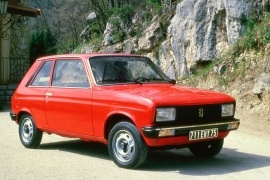PEUGEOT 104 Models/Series Timeline, Specifications & Photos
First production year: 1972
Engines: Gasoline
Body style: Hatchback
Peugeot tried to cover more ground with its cars and offered something for everyone, from small-sized vehicles such as the 104 to the larger 504.
The French automaker made small but steady steps on the market. Its budget-friendly cars were appreciated and better than those offered by the German carmakers, especially in the small-sized segment. Thus, the 104 enjoyed an unusually 16-year-long career, being produced until 1988 with several updates. In 1972, the car was introduced on the market as a four-door-only affair. It was accompanied in the following year by a two-door version.
With a design signed by Paolo Martin, who previously worked for Bertone and was already hired by Pininfarina, the 104 looked fresh on the market. Its wedged shapes were very appreciated by customers. At the front, the black plastic grille sported the brand's badge and was flanked by rectangular headlights. From its profile, the 104 featured flush door handles, leading to a clean look for the vehicle.
The cabin was roomy enough to accommodate up to five occupants. Another important detail was that the passenger area didn't integrate the luggage compartment, like in a hatchback. Later, that idea was dismissed, and the 104 received a tailgate instead of a trunk lid. Paolo Martin also designed a clean-looking dashboard with a small instrument cluster fronting the driver. A pair of low-mounted bucket seats with almost no side bolstering supported the front passengers. At the same time, the bench was virtually flat and offered room for three, albeit the shoulder room was not one of the car's main advantages.
Under the hood, Peugeot installed a choice of three gasoline engines based on the same engine block. Moreover, like the British Mini, the powerplant shared its oil with the gearbox, leading to lower maintenance costs. All these unusual technical details proved valuable in 1973 when the Oil Crisis started, and customers started to look for cheaper-to-run vehicles.
